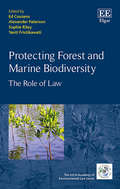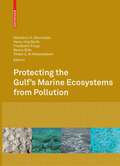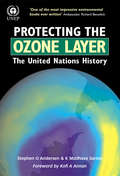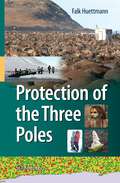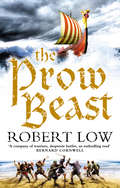- Table View
- List View
Protecting Animals Within and Across Borders: Extraterritorial Jurisdiction and the Challenges of Globalization
by Charlotte E. BlattnerExtraterritorial jurisdiction stands at the juncture of international law and animal law and promises to open a path to understanding and resolving the global problems that challenge the core of animal law. As corporations have relocated and the animal industry (agriculture, medical research, entertainment, etc.) has dispersed its production facilities across the territories of multiple states, regulatory gaps and fears of a race to the bottom have become a pressing issue of global policy. This book provides enough background to allow readers to understand why extraterritorial jurisdiction must respond to these developments, counters objections that readers might raise, and describes how to improve animal law in tandem. The heart of the work is a fully-fledged catalogue of options for extraterritorial jurisdiction, which states can employ to strengthen their animal laws. The book offers top-down perspectives drawn from general international law and trade law, and complements them by a bottom-up up view from the perspective of animal law. The approach connects the law of jurisdiction to substantive law and opens up deeper questions about moral directionality, state and corporate duties owed animals, and the comparative advantages of constitutional, criminal, and administrative animal law. To ensure that extraterritorial animal law does not become complicit in oppressing ethnic and cultural minorities, the book offers critical interdisciplinary perspectives, informed by posthumanist and postcolonialist discourse. Readers will further learn when and how extraterritorial jurisdiction violates international law, and the consequences of exercising it illegally under international law. This work answers questions about how and why extraterritorial jurisdiction can overcome the steepest hurdles for animal law and help move us toward a just global interspecies community.
Protecting Animals Within and Across Borders: Extraterritorial Jurisdiction and the Challenges of Globalization
by Charlotte E. BlattnerExtraterritorial jurisdiction stands at the juncture of international law and animal law and promises to open a path to understanding and resolving the global problems that challenge the core of animal law. As corporations have relocated and the animal industry (agriculture, medical research, entertainment, etc.) has dispersed its production facilities across the territories of multiple states, regulatory gaps and fears of a race to the bottom have become a pressing issue of global policy. This book provides enough background to allow readers to understand why extraterritorial jurisdiction must respond to these developments, counters objections that readers might raise, and describes how to improve animal law in tandem. The heart of the work is a fully-fledged catalogue of options for extraterritorial jurisdiction, which states can employ to strengthen their animal laws. The book offers top-down perspectives drawn from general international law and trade law, and complements them by a bottom-up up view from the perspective of animal law. The approach connects the law of jurisdiction to substantive law and opens up deeper questions about moral directionality, state and corporate duties owed animals, and the comparative advantages of constitutional, criminal, and administrative animal law. To ensure that extraterritorial animal law does not become complicit in oppressing ethnic and cultural minorities, the book offers critical interdisciplinary perspectives, informed by posthumanist and postcolonialist discourse. Readers will further learn when and how extraterritorial jurisdiction violates international law, and the consequences of exercising it illegally under international law. This work answers questions about how and why extraterritorial jurisdiction can overcome the steepest hurdles for animal law and help move us toward a just global interspecies community.
Protecting Forest and Marine Biodiversity: The Role of Law (The IUCN Academy of Environmental Law series)
by Ed Couzens Alexander Paterson Sophie Riley Yanti FristikawatiThis timely book considers appropriate legal practices to use to promote conservation, protection and sustainable use of biological diversity in forest and marine areas. The breadth of issues explored across these two themes is immense, and the book identifies both key differences, and striking commonalities between them. Law-makers, managers and users often have little understanding of either the complexity or the true value of biological diversity and of what is needed to preserve forest and marine ecosystems, and to keep inter-relationships between species within them healthy. Regulators face significant and practical challenges, requiring the adoption of legal frameworks in the context of scientific uncertainty. This book provides critical and comparative reflections on the role of law in both of these biodiversity contexts. Key issues not previously addressed through the law are considered – for example, the lack of international governance of peat; and the moral problem of labelling certain species as ‘alien’ or ‘invasive’. Learned contributors draw valuable lessons for those seeking to protect biodiversity and understand its governance, from analysis of experiences gained forging international and national legal frameworks. With a blend of local and global perspectives, across a wide range of countries and policies, the book will appeal to academics and students in law, international, regional and domestic policymakers, lawmakers, NGOs and conservation agencies.
Protecting Seniors Against Environmental Disasters: From Hazards and Vulnerability to Prevention and Resilience (Earthscan Risk in Society)
by Michael R GreenbergThe baby boom generation were born between 1946 and 1964 and are the largest population cohort in US history. They should number about 90 million by mid-century, more than doubling their current size. The massive increase in seniors and relative decline of those of working age in the US is mirrored in almost all the world’s most populous countries. This book connects the dots between the US baby boom generation and the marked increase in natural and human-caused disasters. It evaluates options available to seniors, their aids, for and not-for and for-profit organizations and government to reduce vulnerability to hazard events. These include coordinated planning, risk assessment, regulations and guidelines, education, and other risk management efforts. Using interviews with experts, cases studies, especially of Superstorm Sandy, and literature, it culls best practice and identify major gaps. It is original and successful in making the connection between the growing group of vulnerable US seniors, environmental events, and risk management practices in order to isolate the most effective lessons learned.
Protecting Seniors Against Environmental Disasters: From Hazards and Vulnerability to Prevention and Resilience (Earthscan Risk in Society)
by Michael R GreenbergThe baby boom generation were born between 1946 and 1964 and are the largest population cohort in US history. They should number about 90 million by mid-century, more than doubling their current size. The massive increase in seniors and relative decline of those of working age in the US is mirrored in almost all the world’s most populous countries. This book connects the dots between the US baby boom generation and the marked increase in natural and human-caused disasters. It evaluates options available to seniors, their aids, for and not-for and for-profit organizations and government to reduce vulnerability to hazard events. These include coordinated planning, risk assessment, regulations and guidelines, education, and other risk management efforts. Using interviews with experts, cases studies, especially of Superstorm Sandy, and literature, it culls best practice and identify major gaps. It is original and successful in making the connection between the growing group of vulnerable US seniors, environmental events, and risk management practices in order to isolate the most effective lessons learned.
Protecting the Gulf's Marine Ecosystems from Pollution
by Abdulaziz H. Abuzinada Hans-Jörg Barth Friedhelm Krupp Benno Böer Thabit Zahran Al AbdessalaamThis volume reviews present sources and levels of pollution in The Gulf, assesses their causes and effects on biota and ecosystems, and identifies preventive and remedial measures reducing levels of pollution and mitigating adverse impacts. It is supported by UNESCO, Doha.
Protecting the Marine Environment From Land-Based Sources of Pollution: Towards Effective International Cooperation
by Daud HassanGlobal findings estimate that 80 per cent of marine pollution originates from land-based sources and is trans-boundary in nature. These problems persist in spite of a number of legal and policy initiatives taken to protect the marine environment. This volume explores the applications and shortcomings of current international regimes in addressing these issues. The book identifies the sources and effects of land-based marine pollution and analyzes the problems of controlling them. Management principles, policy and regulation are examined at both regional and international level. The author discusses the strengths and weaknesses of existing regimes and advances a more effective international legal framework. The text provides a valuable insight into an important area of international environmental law. It will be of interest to researchers and policy-makers working in this area.
Protecting the Marine Environment From Land-Based Sources of Pollution: Towards Effective International Cooperation
by Daud HassanGlobal findings estimate that 80 per cent of marine pollution originates from land-based sources and is trans-boundary in nature. These problems persist in spite of a number of legal and policy initiatives taken to protect the marine environment. This volume explores the applications and shortcomings of current international regimes in addressing these issues. The book identifies the sources and effects of land-based marine pollution and analyzes the problems of controlling them. Management principles, policy and regulation are examined at both regional and international level. The author discusses the strengths and weaknesses of existing regimes and advances a more effective international legal framework. The text provides a valuable insight into an important area of international environmental law. It will be of interest to researchers and policy-makers working in this area.
Protecting the Ozone Layer: The United Nations History
by Stephen O Andersen K Madhava SarmaIn the 1970s the world became aware of a huge danger: the destruction of the stratospheric ozone layer by CFCs escaping into the atmosphere, and the damage this could do to human health and the food chain. So great was the threat that by 1987 the UN had succeeded in coordinating an international treaty to phase out emissions; which, over the following 15 years has been implemented. It has been hailed as an outstanding success. It needed the participation of all the parties: governments, industry, scientists, campaigners, NGOs and the media, and is a model for future treaties. This volume provides the authoritative and comprehensive history of the whole process from the earliest warning signs to the present. It is an invaluable record for all those involved and a necessary reference for future negotiations to a wide range of scholars, students and professionals.
Protecting the Ozone Layer: The United Nations History
by Stephen O Andersen K Madhava SarmaIn the 1970s the world became aware of a huge danger: the destruction of the stratospheric ozone layer by CFCs escaping into the atmosphere, and the damage this could do to human health and the food chain. So great was the threat that by 1987 the UN had succeeded in coordinating an international treaty to phase out emissions; which, over the following 15 years has been implemented. It has been hailed as an outstanding success. It needed the participation of all the parties: governments, industry, scientists, campaigners, NGOs and the media, and is a model for future treaties. This volume provides the authoritative and comprehensive history of the whole process from the earliest warning signs to the present. It is an invaluable record for all those involved and a necessary reference for future negotiations to a wide range of scholars, students and professionals.
Protecting the Third Pole: Transplanting International Law
by Simon MarsdenThis highly topical book considers the important question of how best to protect the environment of the Third Pole – the area comprising the Hindu Kush Himalayas and Tibetan Plateau – using the tool of international law; specifically, international environmental law and the law of international watercourses. Following detailed analysis of weaknesses in current legal protections according to comparative legal theory, Simon Marsden recommends three potential options for implementation by policy and lawmakers. The first option is to transplant existing international law, including conventions from the UN Economic Commission for Europe and the Council of Europe. Secondly, transplantation of a comprehensive international treaty, based upon the Alpine and Carpathian regimes, is suggested. The overwhelmingly European focus of the first two options, and possible contextual constraints to implementation, informs a third option: the development of a new treaty, giving appropriate attention to the Asian context on one hand, and the need for access of information and public participation on the other, to ensure effective implementation and compliance. Taking a comparative, interdisciplinary approach, Protecting the Third Pole will be a key resource for legal and policy scholars. NGO’s and practitioners will also benefit from its detailed analysis.
Protecting the Wild: Parks and Wilderness, the Foundation for Conservation
by George Wuerthner, Eileen Crist and Tom ButlerProtected natural areas have historically been the primary tool of conservationists to conserve land and wildlife. These parks and reserves are set apart to forever remain in contrast to those places where human activities, technologies, and developments prevail. But even as the biodiversity crisis accelerates, a growing number of voices are suggesting that protected areas are passé. Conservation, they argue, should instead focus on lands managed for human use—working landscapes—and abandon the goal of preventing human-caused extinctions in favor of maintaining ecosystem services to support people. If such arguments take hold, we risk losing support for the unique qualities and values of wild, undeveloped nature. Protecting the Wild offers a spirited argument for the robust protection of the natural world. In it, experts from five continents reaffirm that parks, wilderness areas, and other reserves are an indispensable—albeit insufficient—means to sustain species, subspecies, key habitats, ecological processes, and evolutionary potential. A companion volume to Keeping the Wild: Against the Domestication of Earth, Protecting the Wild provides a necessary addition to the conversation about the future of conservation in the so-called Anthropocene, one that will be useful for academics, policymakers, and conservation practitioners at all levels, from local land trusts to international NGOs.
Protecting Traditional Knowledge: The WIPO Intergovernmental Committee on Intellectual Property and Genetic Resources, Traditional Knowledge and Folklore (Routledge Research in International Environmental Law)
by Daniel F. Robinson Ahmed Abdel-Latif Pedro RoffeThis is the first comprehensive review of the Intergovernmental Committee (IGC) of the World Intellectual Property Organization (WIPO) established in 2000. It provides an in-depth consideration of the key thematic areas within WIPO discussions – genetic resources (GRs), traditional knowledge (TK) and traditional cultural expressions (TCEs) through the perspectives of a broad range of experts and stakeholders, including indigenous peoples and local communities. It also looks at how these areas have been treated in a number of forums and settings (including national systems and experiences, and also in trade agreements) and the interface with WIPO discussions. Furthermore, the book analyses the process and the negotiation dynamics since the IGC received a mandate from WIPO members, in 2009, to undertake formal text-based negotiations towards legal instruments for the protection of GR, TK and TCEs. While there has been some progress in these negotiations, important disagreements persist. If these are to be resolved, the adoption of these legal instruments would be a significant development towards resolving key gaps in the modern intellectual property system. In this regard, the book considers the future of the IGC and suggests options which could contribute towards achieving a consensual outcome.
Protecting Traditional Knowledge: The WIPO Intergovernmental Committee on Intellectual Property and Genetic Resources, Traditional Knowledge and Folklore (Routledge Research in International Environmental Law)
by Daniel F. Robinson Ahmed Abdel-Latif Pedro RoffeThis is the first comprehensive review of the Intergovernmental Committee (IGC) of the World Intellectual Property Organization (WIPO) established in 2000. It provides an in-depth consideration of the key thematic areas within WIPO discussions – genetic resources (GRs), traditional knowledge (TK) and traditional cultural expressions (TCEs) through the perspectives of a broad range of experts and stakeholders, including indigenous peoples and local communities. It also looks at how these areas have been treated in a number of forums and settings (including national systems and experiences, and also in trade agreements) and the interface with WIPO discussions. Furthermore, the book analyses the process and the negotiation dynamics since the IGC received a mandate from WIPO members, in 2009, to undertake formal text-based negotiations towards legal instruments for the protection of GR, TK and TCEs. While there has been some progress in these negotiations, important disagreements persist. If these are to be resolved, the adoption of these legal instruments would be a significant development towards resolving key gaps in the modern intellectual property system. In this regard, the book considers the future of the IGC and suggests options which could contribute towards achieving a consensual outcome.
Protection of the Three Poles
by Falk HuettmannThe Arctic, the Antarctic, and the Hindu Kush-Himalayas form a trio of terrains sometimes called “the three poles”. Mainly composed of rock, snow, and ice, these precious regions, which are home to many unique species such as the polar bear, the emperor penguin, and the snow leopard, contain the primary water resource of this planet and directly shape our climate. This book presents a first-ever global assessment and progressive review of the three poles and demonstrates the urgent need for their protection. Sins of the past have irrevocably harmed and threatened many of the unique qualities of these regions, and the future looks bleak with the global population forecast to reach 9 billion by 2060, and with climate change on the rise. Presented here is a wide-reaching and coherent overview of the three poles’ biodiversity, habitats, and ongoing destruction. Failed protection and social targets set by the United Nations and other bodies are exposed while economic growth, unconstrained or inappropriate development, and urban sprawl are promoted unabated. Polar regions play a major role in the global agenda as they are rich in oil and other resources, marking them for contamination, overfishing, and further degradation. Tourism in the Antarctic has benefited from enlightened self-regulation, but there are signs that this is changing, too. The chapters of this book are written by experts in their fields, and their evidence leaves no doubt that we already live beyond our carrying capacity on a finite but decaying space. A global protection role model and several outlook scenarios are proposed to help set in motion polar protection priorities that are actually valid. Humanity has demonstrated through international treaties such as the Antarctic Treaty and the Madrid Protocol that we can put the interests of the planet as a whole first. This must become the norm, not the exception.
Protectors of the Land and Water: Environmentalism in Wisconsin, 1961-1968
by Thomas R. HuffmanSince the beginning of the twentieth century, Wisconsin citizens have promoted innovative environmental programs. During the 1960s Wisconsin was again at the forefront of the movement advancing mainstream political environmentalism. Thomas Huffman traces the rise of environmentalism in the Badger State during these key years, when the people of Wisconsin instituted policies in such areas as outdoor recreation and resource planning, water pollution control, the preservation of wild rivers, and centralized environmental management. Huffman focuses especially on the influence of Senator Gaylord Nelson, a Democrat and founder of Earth Day, and Governor Warren Knowles, a Republican. He shows that their efforts--and the efforts of their followers in citizen groups, the business and university communities, and the state government--clearly indicate that the origins of environmentalism cannot be placed along a left-right political spectrum. Rather, the movement evolved from an interweaving of liberal and conservative ideologies and from important traditions and precedents within the state's environmental culture. What happened in Wisconsin is particularly significant, Huffman points out, because of the effect of that state's example on other states and the federal government.Originally published in 1994. A UNC Press Enduring Edition -- UNC Press Enduring Editions use the latest in digital technology to make available again books from our distinguished backlist that were previously out of print. These editions are published unaltered from the original, and are presented in affordable paperback formats, bringing readers both historical and cultural value.
Protestant Dublin, 1660-1760: Architecture and Iconography (Early Modern History: Society and Culture)
by R. UsherThis innovative urban history of Dublin explores the symbols and spaces of the Irish capital between the Restoration in 1660 and the advent of neoclassical public architecture in the 1770s. The meanings ascribed to statues, churches, houses, and public buildings are traced in detail, using a wide range of visual and written sources.
Protist Diversity and Geographical Distribution (Topics in Biodiversity and Conservation #8)
by W. Foissner David Leslie HawksworthConservation and biodiversity of protists The conservation of biodiversity is not just an issue of plants and vertebrates. It is the scarcely visible invertebrates and myriads of other microscopic organisms that are crucial to the maintenance of ecological processes on which all larger organisms and the composition of the atmosphere ultimately depend. Biodiversity and Conservation endeavours to take an holistic view of biodiversity, and when the opportunity arises to issue collections of papers dealing with too-often neglected groups of organisms. The protists, essentially eukaryotes that cannot be classi?ed in the kingdoms of animals, fungi, or plants, include some of the lea- known groups of organisms on earth. They are generally treated as a separate kingdom, commonly named Protista (or Protoctista) in textbooks, but in reality they are a mixture of organisms with disparate a?nities. Some authors have hypothesized that the numbers of protists are not especially large, and that many have extraordinarily wide distributions. However, the p- ture that unfolds from the latest studies discussed in this issue is di?erent. There are many species with wide ranges, and proportionately more cosmopolitan species than in macroorganism groups, as a result of their long evolutionary histories, but there are also de?nite patterns and geographical restrictions to be found. Further, some protists are linked to host organisms as mutualists or parasites and necessarily con?ned to the distributions of their hosts.
Protocol for Somatic Embryogenesis in Woody Plants (Forestry Sciences #77)
by Shri Mohan Jain Pramod K. GuptaWorld population is increasing at an alarming rate and this has resulted in increasing tremendously the demand for tree products such as wood for construction materials, fuel and paper, fruits, oils and medicines etc. This has put immense pressure on the world’s supplies of trees and raw material to industry and will continue to do so as long as human population continues to grow. Also, the quality of human diet, especially nutritional components, is adversely affected due to limited genetic improvement of most of fruit trees. Thus there is an immediate need to increase productivity of trees. Improvement has been made through conventional breeding methods, however, conventional breeding is very slow due to long life cycle of trees. A basic strategy in tree improvement is to capture genetic gain through clonal propagation. Clonal propagation via organogenesis is being used for the production of selected elite individual trees. However, the methods are labour intensive, costly, and produce low volumes. Genetic gain can now be captured through somatic embryogenesis. Formation of embryos from somatic cells by a process resembling zygotic embryogenesis is one of the most important features of plants. In 1958, Reinert in Germany and Steward in USA independently reported somatic embryogenesis in carrot cultures. Since then, tremendous progress in somatic embryogenesis of woody and non-woody plants has taken place. It offers a potentially large-scale propagation system for superior clones.
Protocols for Micropropagation of Woody Trees and Fruits
by S. Mohan Jain H. HäggmanMicropropagation has become a reliable and routine approach for large-scale rapid plant multiplication, which is based on plant cell, tissue and organ culture on well defined tissue culture media under aseptic conditions. A lot of research efforts are being made to develop and refine micropropagation methods and culture media for large-scale plant multiplication of several number of plant species. However, many forest and fruit tree species still remain recalcitrant to in vitro culture and require highly specific culture conditions for plant growth and development. The recent challenges on plant cell cycle regulation and the presented potential molecular mechanisms of recalcitrance are providing excellent background for understanding on totipotency and what is more development of micropropagation protocols. For large-scale in vitro plant production the important attributes are the quality, cost effectiveness, maintenance of genetic fidelity, and long-term storage. The need for appropriate in vitro plant regeneration methods for woody plants, including both forest and fruit trees, is still overwhelming in order to overcome problems facing micropropagation such as somaclonal variation, recalcitrant rooting, hyperhydricity, polyphenols, loss of material during hardening and quality of plant material. Moreover, micropropagation may be utilized, in basic research, in production of virus-free planting material, cryopreservation of endangered and elite woody species, applications in tree breeding and reforestation.
The Proven Winners Garden Book: Simple Plans, Picture-Perfect Plants, and Expert Advice for Creating a Gorgeous Garden
by Ruth Rogers Clausen Thomas ChristopherProven Winners is known for being the best source for reliable annuals, perennials, and shrubs. Their first book offers all the know‑how you need to grow a great home garden.
The Prow Beast (The Oathsworn Series #4)
by Robert LowThe epic and action packed fourth novel in the Oathsworn series, charting the adventures of Orm and his band of Viking brothers.
Proximal Soil Sensing (Progress in Soil Science #1)
by Raphael A. Viscarra Rossel Alex B. McBratney Budiman MinasnyThis book reports on developments in Proximal Soil Sensing (PSS) and high resolution digital soil mapping. PSS has become a multidisciplinary area of study that aims to develop field-based techniques for collecting information on the soil from close by, or within, the soil. Amongst others, PSS involves the use of optical, geophysical, electrochemical, mathematical and statistical methods. This volume, suitable for undergraduate course material and postgraduate research, brings together ideas and examples from those developing and using proximal sensors and high resolution digital soil maps for applications such as precision agriculture, soil contamination, archaeology, peri-urban design and high land-value applications, where there is a particular need for high spatial resolution information. The book in particular covers soil sensor sampling, proximal soil sensor development and use, sensor calibrations, prediction methods for large data sets, applications of proximal soil sensing, and high-resolution digital soil mapping. Key themes: soil sensor sampling – soil sensor calibrations – spatial prediction methods – reflectance spectroscopy – electromagnetic induction and electrical resistivity – radar and gamma radiometrics – multi-sensor platforms – high resolution digital soil mapping - applications Raphael A. Viscarra Rossel is a scientist at the Commonwealth Scientific and Industrial Research Organisation (CSIRO) of Australia. Alex McBratney is Pro-Dean and Professor of Soil Science in the Faculty of Agriculture Food & Natural Resources at the University of Sydney in Australia. Budiman Minasny is a Senior Research Fellow in the Faculty of Agriculture Food & Natural Resources at the University of Sydney in Australia.
Prozessorientiertes Umweltmanagement: Ein Modell zur Integration von Umweltschutz, Qualitätssicherung und Arbeitssicherheit
by Stefan VorbachStefan Vorbach entwickelt das Konzept eines umfassenden Managementsystems, in dem die bislang getrennten Bereiche Umweltschutz, Qualitätssicherung und Arbeitssicherheit zusammengeführt werden.

